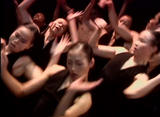
The first part of Lin Hwai-min's calligraphic trilogy. According to the choreographer, this piece derives its inspiration from writing with thick dark ink, whereas the later Cursive II is dominated by lighter semi-transparent tones...



CLOUD GATE DANCE THEATRE
CURSIVE
Choreography Lin Hwai-min
Music QU Xiao-song
(commissioned by
Quanta Education Foundation)
Set & Image Design Lin Keh-hua
Lighting Design CHANG Tsan-tao
Costume Design Lin Jing-ru
Duration 70 minutes without intermission
Co-Commission
The National Theatre, Taipei
Auditorium Theatre Council, Chicago
Hancher Auditorium, University of Iowa
World Premiere
December 1, 2001 at National Theatre, Taipei
Cursive is a lyrical dance with its title and movement ideas inspired by Chinese calligraphy.
ABOUT CURSIVE
Cursive is the result of a long journey into ancient practice of movement and spirituality. Under the direction of choreographer Lin Hwai-min, Cloud Gate Dance Theatre of Taiwan has been exploring traditional Chinese body disciplines. Songs of the Wanderers (1994), comes from the practice of meditation. Moon Water (1998), featured at the Sydney 2000 Olympic Arts Festival, owes its movement motives to Tai Chi Tao Yin, a Chi Kung exercise that can be traced back to more than 2000 years ago. Both works have received high acclaim at prominent festivals throughout the world.
In 2001, Lin Hwai-min further explored the possibilities of Tai Chi Tao Yin and martial arts, and created Cursive, with its title derived from Chinese calligraphy. After studying Chinese calligraphy masterpieces, Lin found, despite the differences in styles, all the brush works share one common element: the focused energy with which the calligraphers “danced” during writing. He asked Cloud Gate dancers to improvise by facing blown-up images of calligraphy. The dancers absorbed the energy, or Chi, of the writer and imitated the linear “route” of ink, full of lyrical flows and strong punctuations with rich variations in energy. The exercise produced unimaginable movements, from subtle slow motions to martial-arts-like attacks with powerful energy. These eventually became the movement material for Cursive, a work of stunning beauty that has received rave reviews in Europe and the U.S.
For the choice of music, Lin commissioned a score from Qu Xiao-song, a renowned Chinese contemporary composer based in Shanghai. It is a chamber work that features a cello and three percussion instruments recorded by Reimund Korupp & Percussion Plus in Heidelberg, Germany. The tension in the music comes from the contrast between the flow of the cello and the punctuations and explosions from the percussion instruments. With its plentiful empty spaces, the music also has a meditative quality. Lin likes the empty space in classical Chinese landscape paintings. And he loves the way one views classical painting in which the images unfold as if a scroll is being rolled open. It is a form of meditation. Lin Hwai-min hopes Cursive, though not as slow as Songs of the Wanderers or Moon Water in pace, will be able to give the viewers a sense of viewing an unfolding Chinese scroll.
The look of Cursive, however, is contemporary. Dancers dressed in black perform on a stage covered with white marley, just like black ink on white rice paper. Video and slide projections on several gigantic white screens serve as the only set for the work. For each scene, screens change to either reveal black drapes upstage or hang in mid-air. Calligraphy is the sole content of the projections. Close-ups of characters by master calligraphers are beautiful and abstract, defying the meaning of the characters but echoing the energy flow of the dancers.
(http://www.cloudgate.org.tw/eng/english ... text01.htm)